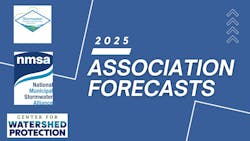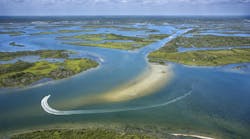2025 Association Forecasts: Where three stormwater associations see the industry heading
From a change in presidential administration to funding and new technology, 2025 is sure to bring change to the stormwater industry. Below, leaders from various associations share what they see coming down the pipeline for the stormwater industry.
What is driving the industry in 2025?
By Hye Yeong Kwon, executive director/ CEO of the Center for Watershed Protection
Climate resiliency, the Bipartisan Infrastructure Law (BIL), changes in federal leadership, and the job market are a few of the biggest trends and challenges that I see in the stormwater sector in 2025.
Depending on where you live, flooding, fires, and other climate-related impacts have continued to hit the headlines in 2024, and 2025 is certain to generate new stories. Climate change and its impacts have required communities to tackle a new norm in nuisance flooding and weather-related events. The challenge for communities is how they can be more resilient to these impacts which often have unpredictable and devastating results.
Funding commitments through the BIL has allowed communities to start to tackle some of these challenges and with over $50 billion of the $1.2 trillion allocated to water pollution projects, 2025 will see continued progress on stormwater. With most of these funds already committed, we should see continued projects, progress, and jobs as a result of these investments into 2025 and beyond.
Furthermore, with new federal leadership, there are bound to be changes that affect stormwater management. This includes how and what projects are funded or reprogrammed; regulation changes; and/or the type of issues that become new priorities or de-prioritized. While the past may be a signal of what is to come in the future, many of us are anxious to know what changes the new administration will bring for the stormwater industry.
Lastly, the low unemployment rate has created challenges for growing organizations and hiring managers. Combined with the retired baby boomer challenges, many positions have continued to be left unfilled. Additionally, there is a growing need for workers in green infrastructure jobs. Training, hiring and retention in this industry are likely to remain challenges for 2025.
What will happen at a national level?
By Seth Brown, executive director of the National Municipal Stormwater Alliance
Before looking ahead at 2025, we should look back at 2024 and recognize it as a year of continued market growth as well as policy dynamics. The labor market in stormwater is strong as reflected in the most recent Water Environment Federation (WEF) National MS4 Needs Assessment Survey that identified workforce and staffing needs as one of the top challenges facing stormwater programs. Consolidation in the manufactured device continues with Oldcastle Infrastructure acquiring Hydro International. On the legal and policy front, the U.S. Supreme Court (SCOTUS) ruled to overturn the Chevron Doctrine that is the most-cited ruling in SCOTUS history and that has been the basis of administrative actions for over 40 years, and the Court also heard a case centered around CSO discharges in the San Fransisco area that questions the use of narrative language in NPDES permits.
In addition, the State of Washington issued a draft industrial permit that includes the first requirement for monitoring of PFAS. In October, U.S. Environmental Protection Agency (EPA) Region 1 re-issued a Preliminary Designation pursuant to the Residual Designation Authority (RDA) in the Clean Water Act (CWA), which targets discharges from commercial, industrial, and institutional (CII) properties of one acre or more of impervious cover specified watersheds in Massachusetts. Lastly, the U.S. EPA issues a draft of the updated Multi-Sector General Permit (MSGP) late in 2024. Comments for both the RDA designation and the MSGP are due in late January 2025.
Moving forward, the strength in the stormwater market is expected to continue, but considering the historic infusion of investment in the water sector through the Infrastructure Investment and Jobs Act (IIJA) of 2021 is set to sunset in 2026, this growth may slow. Staffing challenges are likely to continue as well in this sector. The biggest uncertainties in stormwater for 2025 are likely to be in the policy and legal areas. The San Francisco SCOTUS ruling is expected in the spring of 2025 that could significantly impact the nature of NPDES permits, including the Maximum Extent Practicable (MEP) basis of the MS4 regulatory program, and the impacts of the overturning of Chevron may become more evident in 2025. Of course, the biggest impact on the policy front is the return of Donald Trump to the presidency. Based upon Project 2025, an initiative that may influence the Trump Administration, there is likely to be a continued focus to limit the extents of Waters of the U.S. (WOTUS), but there is also an identified need to increase investment in the EPA Clean Watershed Needs Survey (CWNS) to better identify critical areas of investment in the water sector. It should be noted that the publication of the 2022 CWNS signals a level of need in the stormwater sector that is over 350% greater than the previous survey from 2012, so increased funding of this program is likely to continue to highlight needs in our sector. Other areas expected to be of focus in the new administration include nutrient credit trading, water workforce challenges, and a push for states to obtain regulatory primacy.
For the National Municipal Stormwater Alliance (NMSA), in 2025 we will be focusing on growing our MS4 membership and continuing the momentum of progress in our Stormwater Testing and Evaluation for Products and Practices (STEPP) program. We will continue to partner with WEF and others to host the 9th annual National Stormwater Policy Forum in April, and we will work to support the fourth WEF National MS4 Needs Assessment Survey. We also will be working with American Rivers and others to drive leadership in the stormwater sector for national organizations with an interest in stormwater issues. NMSA looks forward to working with our partners in the Cold Climate Center of Excellence for Stormwater Infrastructure Technology to start the important work of driving research in treatment, programmatic development and funding and financing in the stormwater sector. Lastly but not least, we will be continuing the partnership with StormCon by hosting a day-long track of sessions at StormCon 2025 covering national issues in policy, research, and rising issues of the day in stormwater.
Where is stormwater treatment heading?
By Greg Williams, president of the Stormwater Equipment Manufacturers’ Association
As much as I would like to go viral for making some bold prediction about the stormwater industry, there are two things working against that. First, as an engineer by nature, I am not inclined toward bold predictions. Second, the stormwater industry does not lend itself to earthshattering news. In fact, disasters such as earthquakes and floods are the type of thing we actively avoid.
What does that leave me with for material? There are a few things that make sense for the industry to do that are being talked about a lot but, for various reasons, acted on a little. I think these will form the basis for some trends in 2025. Here they are, in no particular order.
- Increased adoption of standards. There are a number of factors driving this. First is the availability of more ASTM standards, including a standard for laboratory testing of HDS. Second is the launch of a national verification program, STEPP, based on the ASTM standards. This combination will make it easier for jurisdictions to ease their decision-making process by relying on third party verified data.
- Standards will come to the trash capture device (TCD) market. This is very closely tied to item 1 above. I split it out because TCDs are different from HDS and filters in that they currently have no verified performance data. HDS have NJACT reports and filters have TAPE reports but TCDs have nothing. That will change this year as STEPP starts publishing TCD performance reports.
- More sizing for resilience. This has already started but the effort is hindered by the lack of a standard method for accounting for increased rainfall. Science is getting better every day, and NOAA Atlas 15 will address increasing rainfall. These two factors will decrease the risk of sizing for the future, which will lead to more such sizing.
- More treatment trains. With the advent of manufactured stormwater treatment devices in the 80s and 90s the stormwater treatment industry went gray. Naturally the pendulum swung the other way and in the 2010s the industry started to go green. Now, halfway through the 2020s, we are starting to see a swing to the middle as treatment trains are used to address the weaknesses of green or gray solutions on their own.
This last one is a question that could indicate a trend. What has happened to vortex separators? As of January 1, 2025, all HDS must have tested to the 2021 NJDEP protocol in order to be certified. A look at the NJCAT Technology Verification Database reveals that there are now only seven certified HDS on the active list, with 20 now archived. Of the seven active devices, only one has a traditional swirl type flow pattern. Will the once dominant technology make a resurgence?
About the Author
Hye Yeong Kwon
Hye Yeong Kwon is executive director/CEO of the Center for Watershed Protection.
Seth Brown
Seth Brown has over 25 years of experience in the water sector and is the Principal and Founder of Storm and Stream Solutions, LLC, a consulting firm providing a range of services from policy and alternative project delivery analysis in the stormwater sector to facilitation and training services focused on stormwater topics. He was the Director of Stormwater Programs at the Water Environment Federation from 2010-2015 and is currently the Executive Director of the National Municipal Stormwater Alliance, which is a 501.c.3 representing stormwater-focused organizations in 24 states across 9 of the 10 U.S. EPA regions with a network that is comprised of over 4,000 MS4s.
Seth has a Ph.D. in civil engineering from George Mason University with a research focus on socio-economic modeling of incentive-based investments of green stormwater infrastructure on private properties. He leads courses in Green Infrastructure and Innovative Water Partnerships at Virginia Tech and the University of Maryland at Eastern Shore and is a licensed professional engineer in the state of Maryland.
Greg Williams
Greg Williams is president of the Stormwater Equipment Manufacturers’ Association.


